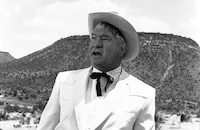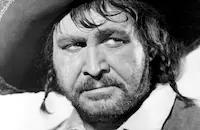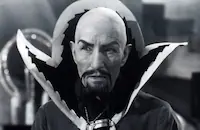Western Union

Brief Synopsis
Cast & Crew
Fritz Lang
Robert Young
Randolph Scott
Dean Jagger
Virginia Gilmore
John Carradine
Film Details
Technical Specs

Synopsis
In 1861, Western Union engineer Edward Creighton is surveying a telegraph line when he is severely wounded in an accident. Bank robber Vance Shaw, on the run from a posse, comes upon Creighton and saves his life while eluding his pursuers. After Creighton recovers, he returns to Omaha, Nebraska, where he intends to build a telegraph line to Salt Lake City, Utah. There is much opposition to the line from Confederate soldiers, Indians and outlaws, but Creighton intends to get the job done with the help of his sister Sue, foreman Pat Grogan and assistant Homer Kettle. Unaware of Shaw's past, Grogan hires him as a scout, and Creighton allows him to stay, as Shaw has professed a desire to reform. They are joined by tenderfoot Richard Blake, a Harvard-educated engineer whom Creighton hires as a favor to Blake's father. Blake and Shaw compete for the affections of Sue, but their romantic rivalry is short-lived, for on 4 July 1861, construction of the line begins. The work is arduous, but the company makes progress until a mysterious attack, reportedly by Indians, devastates the camp. Shaw is suspicious, however, saying that he does not think Indians would be interested in their cattle, which have been stolen. Shaw leaves to investigate and follows the culprits' trail to the camp of Jack Slade, his former cohort. Slade and his gang, which Shaw quit after the bank robbery, admit to dressing as Indians to rustle the company's cattle. Unable to betray his former comrades, Shaw tells Creighton that a large band of Dakota Indians stole the cattle, and that it would be better to replace them than to risk a fight. Soon after, men working on the forward line are approached by a band of drunken Indians, and the nervous Blake shoots one despite Shaw's orders to remain calm. While they are distracted by the Indians, who mean no real harm, the main camp is attacked by Slade's men, who are again disguised as Indians. The company discovers the ruse when one of the wounded "Indians" is revealed to be white, and Creighton grows suspicious of Shaw's involvement when they are forced to buy back their stolen horses from Slade, whom Shaw admits knowing. Creighton then must convince Chief Spotted Horse to allow them to build the line through Indian terrritory, even though the man Blake wounded was Spotted Horse's son. After Creighton persuades the Indians, work continues until the company is almost at Salt Lake City. Slade's men strike again, however, after luring Shaw from the camp and tying him up. Shaw escapes and returns to the company's camp, which has been nearly destroyed. Convinced of Shaw's complicity, Creighton fires him, but before he leaves, Shaw reveals to Blake that Slade is his brother. Shaw then finds Slade and his men in a nearby town and is killed in a gunfight with them. Shaw's death is avenged by Blake, who follows him and kills Slade. Soon after, the line is completed, and as Creighton and Sue celebrate, he tells her that Shaw can hear them.

Director

Fritz Lang
Cast

Robert Young

Randolph Scott

Dean Jagger

Virginia Gilmore

John Carradine

Slim Summerville

Chill Wills

Barton Maclane

Russell Hicks
Victor Kilian

Minor Watson
George Chandler
Chief Big Tree
Chief Thundercloud
Dick Rich

Addison Richards

Irving Bacon
Harry Strang

Charles Middleton
Francis Ford
Eddy Waller
Reed Howes
Tom London
Steve O'brien
Paul Burns
Arthur Aylsworth
Cliff Clark
Russ Clark
Frank Mills

Ralph Dunn

James Flavin
Kermit Maynard
Herman Nowlin
John Epper
Larry Dodds
Sid Jordan
Robert Clarke
Captain C. E. Anderson
Bill Beauman
George Plues
Hank Bell
Earl Dobbins
Cecil Kellogg
Merlyn Nelson
Ed Warren
Frank Ellis
Tommy Coats
Joe P. Smith
Clint Sharp
Frank Mcgrath
Boone Hazlett
Joe E. Molina
Tony Urchel
Jim Spencer
Iron Eyes Cody
Harold A. Malendez
Clarence Chorre
Sonny Chorre
Harry "silverheels" Smith
Bahe Denetdeel
Jack Henry Fritz
J. W. Cody
Crew
Jack Andrews
Travis Banton
Robert Bischoff
Harry Brand
Steve Brandt
Otto Brower
Harry Joe Brown
George Bruce
Jerry Bryan
David Buttolph
Robert Carson
Tom Clark
William Cline
Nelson Cordes
Bob Cowan
Russel Crane
Edward Cronjager
Henry Cronjager
Carl W. Daniels
Allen M. Davey
Richard Day
Fred Fox
Bernard Freericks
Max Goldman
Gordon Gordon
Robert E. Goux
Don Greenwood
Fred H. Hall
Fay Hamblin
Roger Heman
Hal Herman
Albert Hogsett
Bruce Hunsaker
Harry Jackson
Harry R. Jones
Natalie Kalmus
Buddy King
Charles King
William Koenig
Max Lauer
Thomas Little
Ray Lopez
Joe Macdonald
Roger Mace
Robert Martien
Horace Mccoy
William Mittlestedt
Joe Noecker
Morgan Padelford
Roy Pierce
Frank Powolny
H. B. Romey
Marguerite Royce
Stanley Scheuer
Clarence Schiffer
Lynn Shores
William Sittel Jr.
W. R. Snyder
Ben Southland
Lemuel Tribe
Paul Uhl
Henry Weinberger
Arthur Wright
Saul Wurtzel
Darryl F. Zanuck

Film Details
Technical Specs

Articles
Western Union
Lang's interest in cowboy culture was not strictly a hobby. He made several westerns while working in Hollywood, including the Technicolor epic Western Union (1941).
When Vance Shaw (Randolph Scott), a fugitive from justice, encounters a wounded man in the wilderness, he tends the man's wounds and helps him to a town where he can receive medical attention. The wounded man is Edward Creighton (Dean Jagger), an engineer in charge of running a telegraph wire from Omaha to Salt Lake City. While hiring men for the difficult crusade, Creighton overlooks Shaw's criminal background and offers him a job as a scout to repay the debt. Shaw quickly becomes interested in Creighton's sister Sue (Virginia Gilmore), as does the tenderfoot Richard Blake (Robert Young), who joins the mission from back east, sporting fringed, tailored western attire. Blake soon earns the respect of his peers as they travel into the wilderness. But friendships grow strained when the group's supply of cattle is stolen. Creighton suspects Shaw knows something of the crime, which he does. Shaw recognizes the work of his own brother Jack Slade (Barton MacLane), whose gang rustles cattle dressed up as Native American warriors. Unwilling to betray his brother, Shaw searches for a way to avenge the crimes without jeopardizing Western Union's westward campaign.
Western Union was the final novel by Western writer Zane Grey. The book was published three days prior to the author's death of a heart attack on October 23, 1939. Grey had discussed with actor Gary Cooper the idea of an independent production of Western Union (to be released by either United Artists or RKO), but it failed to materialize. At one point Paramount Pictures was also interested in purchasing screen rights, but Fox ultimately won the property with a $25,000 offer.
In many ways Western Union is a relatively authentic depiction of life and work in the Old West, largely due to location shooting near Kanab, Utah and at Arizona's House Rock Canyon. The outstanding Technicolor photography, by Edward Cronjager and Allen M. Davey, made the most of the exotic settings, favoring muted colors and dusky earthtones, occasionally offset by bursts of vivid color, such as the warpaint or ceremonial feathers of the Native American characters. American Cinematographer called it "one of the most spectacularly beautiful examples of color cinematography we've seen in many months."
Western Union tried to avoid the artifice of the stereotypical western, and the scene in which Blake arrives dressed more like a stage dandy than a horseman seems to be a jab at the colorful (but not very genuine) cowboys who populated matinee screens of the era.
Lang discussed the film's authenticity with Peter Bogdanovich in 1965. "I got a letter from a club of Old Timers in Flagstaff which said, 'Dear Mr. Lang, We have seen Western Union and this picture describes the West much better than the best pictures that have been made about the West...' For a European director to get such a thing from Old Timers who knew about the West -- I was, naturally, very flattered; but I suppose what these gentlemen wrote was not quite correct. Because I don't think the picture really depicted the West as it was; maybe it lived up to certain dreams, illusions -- what the Old Timers wanted to remember of the old West."
One of Lang's departures from reality was in the casting of the Native Americans. Because the local Paiute tribesmen didn't fit the stereotype of the chiseled desert warrior, Lang (according to The New York Times), "ordered a shipment of Hollywood Indians from Central Casting -- tall, high cheek-boned fellows who look like aborigines are supposed to look." This order was soon canceled, after Lang discussed the matter with John Collier, Commissioner of Indian Affairs. Collier allowed Lang to instead recruit 200 Navajos from a reservation, under the promise that they would be treated with dignity.
Lang was astute enough to realize that, no matter how well constructed and photographed, his West was just a higher grade of fantasy than the typical Hollywood oater. He had tried to inject some period detail into Western Union, but quickly encountered resistance at 20th Century-Fox. "I had found...that there were cowboys in those days who wore bowler hats. But this was already too much for the studio. Not that they didn't believe it, but they always preferred to give an audience the same old thing -- with some new trimming." When first offered the project, Lang thoroughly rewrote the script, presumably to give it more of a factual feel, but his draft was discarded by the studio. Still believing in the project, even if his ideas were largely ignored, he agreed to continue as planned and direct the film. Besides, maybe the true story of Western Union's westward expansion wouldn't have made such a great movie anyway.
"In reality, nothing happened during the entire building of the line except that they ran out of wood for the telegraph poles," Lang explained, "and the only other thing that disturbed the laying of the line was the ticks on the buffaloes; the buffaloes got itchy and rubbed themselves against the poles, and the poles tumbled. And that was all that happened."
Making a film about laying the telegraph line was apparently twice as complicated as the original task. A 1941 newspaper article reported that "In 1861 it cost $212,000 to extend the telegraph...and the crew took four months and eleven days, covering 1,100 miles. To reproduce their feat in 1940, a company of 300 traveled 2,000 miles in ten months, at a cost of more than $1,000,000."
Lang and company seem to have also doubled the amount of planning that went into the mission. Assistant editor Gene Fowler, Jr. recalled, "On Western Union I learned of the immense preparation that goes into a Lang picture...Models of sets were built and camera angles and focal lengths of lenses were selected. He believed that each shot must relate to the whole. The design of the shot (even the lighting) must relate to the dramatic concept. Details, no matter how good or how interesting, are only good if they fit into the overall pattern."
Director: Fritz Lang
Producer: Darryl F. Zanuck
Screenplay: Robert Carson, based on the novel by Zane Grey
Cinematography: Edward Cronjager and Allen M. Davey
Production Design: Richard Day and Albert Hogsett
Music: David Buttolph
Cast: Randolph Scott (Vance Shaw), Dean Jagger (Edward Creighton), Robert Young (Richard Blake), Virginia Gilmore (Sue Creighton), John Carradine (Doc Murdoch), Slim Summerville (Herman), Chill Wills (Homer Kettle), Barton MacLane (Jack Slade).
C-96m. Closed captioning.
by Bret Wood

Western Union
Quotes
He's being slapped with a spade right now.- Charlie
Trivia
Notes
The film's opening title card reads "Twentieth Century-Fox Presents Zane Grey's Western Union." Although some modern sources assert that Grey did not write a novel entitled Western Union, and claim that the film was instead based on an original story by studio writers, the Twentieth Century-Fox Records of the Legal Department, located at the UCLA Arts-Special Collections Library, indicate that Grey did write the novel, which was published on October 20, 1939, three days before his death. Both Grey's novel, his last, and the film present a fictional account of the real Edward Creighton, a Western Union engineer who helped survey and build the telegraph line from Omaha, NE to Salt Lake City, UT. A January 26, 1941 New York Herald Tribune article commented about the film: "In 1861 it cost $212,000 to extend the telegraph from Omaha to Salt Lake City, and the crew took four months and eleven days, covering 1,100 miles, to do the job. To reproduce their feat in 1940, a company of 300 traveled 2,000 miles in ten months at a cost of more than $1,000,000."
According to a October 26, 1939 Hollywood Reporter news item, Paramount attempted to acquire rights to Grey's novel. Grey's son, Romer, reportedly revealed that before his father's death, "negotiations had been on for Gary Cooper to star in the production which [Grey] was to produce for either United Artists or RKO release." Twentieth Century-Fox obtained the rights to Grey's novel in November 1939 for $25,000, and according to a Hollywood Reporter news item, the studio also purchased an original story by Ward Wing about the history of the Western Union company. Apparently the studio did not intend to use Wing's material, but purchased it "to forestall any conflict with the Zane Grey yarn." A modern source states that executive producer Darryl F. Zanuck originally considered assigning Irving Pichel as the film's director. Studio legal records indicate that writers Albert Shelby LeVino, Curtis Kenyon and Kenneth Earl worked on early drafts of the film's screenplay, but the extent of their contribution to the completed picture has not been confirmed.
A August 12, 1940 Hollywood Reporter news item announcing the signing of Fritz Lang as director also noted that Brenda Joyce had been cast in the feminine lead, and Don Ameche and Lloyd Nolan had been assigned to leading roles. On September 11, 1940, however, Hollywood Reporter noted that Twentieth Century-Fox was borrowing Robert Young from M-G-M to replace Ameche. Other Hollywood Reporter news items stated that Laird Cregar would be in the cast, then announced that because he was being held up by his work in Hudson's Bay, he was to be replaced by George "Gabby" Hayes, but illness prevented Hayes from appearing in the finished film. Lucille Miller and Esther Brodelet were included in the cast by Hollywood Reporter news items, but their participation in the completed film has not been confirmed. A Hollywood Reporter news item also included Mary Astor in the cast, but she does not appear in the released picture. Actor Chill Wills was borrowed from M-G-M for the production.
A October 21, 1940 Hollywood Reporter news item noted that during principal photography, the film's script was sent "back to writer George Bruce with instructions to build up the part of Virginia Gilmore." The extent of Bruce's contribution to the released film has not been determined, however. The picture was largely shot on location at Kanab and Zion National National Park, UT, and House Rock Canyon, AZ. According to a September 26, 1940 Hollywood Reporter news item, fourteen Native Americans traveled from Hollywood to the Kanab location because "any arrangements for use of government reservation Indians in that territory [would involve] too much 'red tape.'" A December 1, 1940 New York Times article reported that Lang did not cast the local Piute Indians in the picture "because of their stature [which meant that] they didn't look like the customers' conception of Indians." The article stated that instead, Lang "ordered a shipment of Hollywood Indians from Central Casting-tall, high cheek-boned fellows who look like aborigines are supposed to look." According to a studio press release, Twentieth Century-Fox actor Henry Fonda, who had once worked as a lineman and in telegraph laboratories in Minneapolis, served as a technical advisor on the production.
According to a Hollywood Reporter news item, in December 1940, the studio purchased J. Hyatt Downing's novel Sioux City, intending to produce it as a "follow-up" to Western Union. Randolph Scott and Laird Cregar were to star in the picture, but it was never made.














